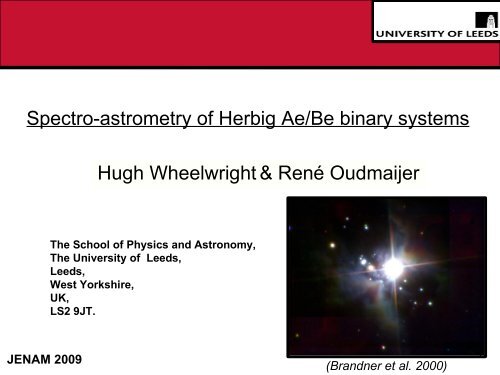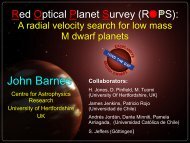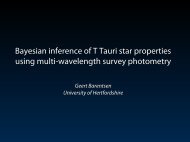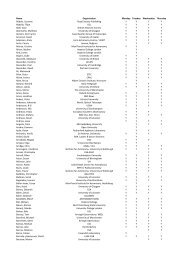Spectro- Astrometry of Herbig Ae/Be Binary Systems
Spectro- Astrometry of Herbig Ae/Be Binary Systems
Spectro- Astrometry of Herbig Ae/Be Binary Systems
Create successful ePaper yourself
Turn your PDF publications into a flip-book with our unique Google optimized e-Paper software.
<strong>Spectro</strong>-astrometry <strong>of</strong> <strong>Herbig</strong> <strong>Ae</strong>/<strong>Be</strong> binary systems<br />
JENAM 2009<br />
Hugh Wheelwright & René Oudmaijer<br />
The School <strong>of</strong> Physics and Astronomy,<br />
The University <strong>of</strong> Leeds,<br />
Leeds,<br />
West Yorkshire,<br />
UK,<br />
LS2 9JT.<br />
(Brandner et al. 2000)<br />
1
<strong>Herbig</strong> <strong>Ae</strong>/<strong>Be</strong> stars<br />
Young stars <strong>of</strong> intermediate mass<br />
(M * ~2-10 M Θ ) - still contracting to the<br />
ZAMS (<strong>Herbig</strong>, 1960).<br />
Most massive objects that experience an<br />
optically visible PMS evolutionary phase.<br />
Known to have a relatively high binary<br />
fraction, e.g. (Pirzkal et al. 1997).<br />
JENAM 2009<br />
From van den Ancker et al. (1997).<br />
2
<strong>Herbig</strong> <strong>Ae</strong>/<strong>Be</strong> binarity<br />
High binary fraction: 68 +/- 11%<br />
(Baines et al. 2006).<br />
<strong>Binary</strong> properties can constrain binary<br />
formation mechanisms: e.g.<br />
• distribution <strong>of</strong> mass ratio<br />
(Woitas et al. 2001)<br />
• orientation <strong>of</strong> circumstellar disks and<br />
binary orbit (Wolf et al. 2001).<br />
Aims: Obtain mass ratio <strong>of</strong> <strong>Herbig</strong><br />
<strong>Ae</strong>/<strong>Be</strong> binary systems.<br />
Method: Use spectro-astrometry to split<br />
unresolved spectrum into<br />
constituent spectra.<br />
JENAM 2009<br />
ΔΘ<br />
The difference between the circumprimary<br />
disk and binary position angle,<br />
from Baines et al. (2006).<br />
3
<strong>Spectro</strong>-astrometry<br />
Schematic<br />
representation <strong>of</strong><br />
spectro-astrometry.<br />
JENAM 2009<br />
4
Results: binary detections<br />
Sample: 47 <strong>Herbig</strong> <strong>Ae</strong>/<strong>Be</strong> stars.<br />
Detect all but 1 known close binaries.<br />
12 new close binary detections.<br />
High binary fraction, 0.68.<br />
JENAM 2009<br />
<strong>Spectro</strong>-astrometric example: MWC 120.<br />
5
Splitting binary spectra<br />
Use the spectro-astrometric<br />
signatures over photospheric lines<br />
to separate binary spectra.<br />
Two methods, see: Bailey (1998a),<br />
Porter et al. (2004).<br />
Use the separated constituent<br />
spectra to spectrally type binary<br />
components, and hence determine<br />
the mass ratio. GU CMa: spectro-astrometric<br />
signatures over different lines.<br />
JENAM 2009<br />
6
Splitting binary spectra: example<br />
HD 245906:<br />
Separation ~ 0.1”<br />
JENAM 2009<br />
Separated spectra <strong>of</strong> the close HD 245906 binary system.<br />
A2<br />
G5<br />
7
Splitting binary spectra: example<br />
GU CMa:<br />
Separation ~ 0.6”<br />
JENAM 2009<br />
Separated spectra <strong>of</strong> the close GU CMa binary system.<br />
B1<br />
B2<br />
8
Results: binary mass ratio<br />
Observed + undetectable systems<br />
Estimated mass ratio <strong>of</strong> 14 close<br />
binary systems.<br />
Compare mass ratio distribution<br />
with random selection <strong>of</strong><br />
secondary mass from IMF, from<br />
Kroupa (2001).<br />
Mass ratio distribution skewed<br />
towards equal mass systems.<br />
This is not consistent with<br />
random pairing from the IMF.<br />
JENAM 2009<br />
Mass ratio distributions<br />
Predicted<br />
Observed<br />
9
Conclusions<br />
<strong>Binary</strong> mass ratio inconsistent with random selection <strong>of</strong> secondary from<br />
IMF.<br />
Either:<br />
• Fragmentation process results in two components <strong>of</strong> comparable mass.<br />
• Post-fragmentation processes alter system, e.g. hardening by dynamical<br />
decay <strong>of</strong> a tertiary system (Goodwin et al. 2007), or binary system<br />
interactions may destroy low mass ratio systems preferentially<br />
(Hubber & Whitworth 2005).<br />
Future work:<br />
Put correlation between circum-primary disks and binary orbital plane<br />
on firmer statistical footing: on-going.<br />
JENAM 2009<br />
10
References<br />
Bailey, J. A., 1998, SPIE Conference, Vol. 3355, 32-939<br />
Baines D., Oudmaijer R. D., Porter J. M., and Pozzo, M., 2006, MNRAS, 367, 737-753<br />
Bouvier J. & Corporon P., The Formation <strong>of</strong> <strong>Binary</strong> Stars Proc IAU Symp 200, 479<br />
Brandner W. et al, AAS 195th Meeting, January 2000,<br />
http://www.aas.org/publications/baas/v31n5/aas195/898.htm, date and time<br />
accessed: 23:35 23/05/08<br />
Goodwin,S. P. et al., 2007, PPV, 133<br />
<strong>Herbig</strong> G. H., 1960, AJS, 4, 337<br />
Hubber D. A. & Whitworth A. P., 2005, A&A, 437, 113<br />
Kroupa P., 2001, MNRAS, 322, 231<br />
Pirzkal, N. Spillar, E. J., Dyck H. M., 1997, ApJ, 481, 392<br />
Porter, J. M., Oudmaijer, R. D., Baines, D., 2004, A & A, 428, 327<br />
Van den Ancker et al, 1997, A & A, 324, L33-L36<br />
Wheelwright H. E., Oudmaijer R. D., Schnerr R. S., 2009, A&A, 497, 487<br />
Woitas J. Leinert C., Köhler R., 2001, A&A, 376, 982<br />
Wolf S., Stecklum B, Henning T., 2001, The Formation <strong>of</strong> <strong>Binary</strong> Stars Proc IAU Symp<br />
200, 295.<br />
JENAM 2009<br />
11





